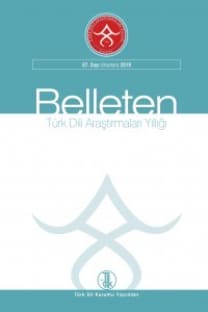MERSİN (İÇEL) VE KIBRIS TÜRK AĞIZLARINDA GENİŞ ZAMAN ÇEKİMİ
Türkiye Türkçesi ağızlarının dil bilgisinin hazırlanıp sınıflandırmasının yapılabilmesi için karşılaştırmalı çalışmalar önem taşımaktadır. Türkiye Türkçesi ağızlarının bir kolunu da Kıbrıs Türk ağızları oluşturmaktadır. Mersin (İçel) ağızları ile Kıbrıs Türk ağızları arasında, söz varlığı ortaklıkları yanında, sesle ilgili özelliklerde denklikler ve biçim bilimsel koşutluklar da bulunmaktadır. Bu çalışmada Mersin (İçel) ve Kıbrıs Türk ağızlarında geniş zaman çekimi karşılaştırılmış, bu bakımdan iki ağız arasındaki benzerlikler ve farklılıklar üzerinde durulmuştur. Yeri geldikçe Türkçenin eski ve yaşayan Türk lehçelerindeki benzer biçimlerle de bağlantısı kurulmaya çalışılmıştır. Çalışmamız, Mersin (İçel) ağızlarından derlediğimiz, Kıbrıs Türk ağızlarından ise derleme, soruşturma ve yazılı kaynaklardan tarama yolu ile elde ettiğimiz veri tabanına dayanmaktadır. Bu ağızların geniş zaman çekimi açısından en belirleyici özelliği, II. tekil kişide adıl kaynaklı (I. tip) kişi ekinin yerini iyelik kaynaklı (II. tip) kişi ekinin alması ve olumsuz eylemlerin geniş zamanlı II. tekil kişi çekiminde geniş zaman ekinin eriyip yok olmasıdır: biliŋ, bilmeŋ “bilirsin, bilmezsin”. Her iki ağızda da, adıl kaynaklı kişi eki kullanıldığında, ekin son sesi damaksıllaşır (-sIn ˃sIŋ): bilirsiŋ, bilmessiŋ, yalançısıŋ. Bu kullanım daha çok ek eylemin geniş zamanlı çekiminde görülmektedir. Zaman zaman da iyelik kaynaklı kişi eki ile adıl kaynaklıların ikili kullanımına rastlanmaktadır. II. çoğul kişi eki de hep art damak n’si ile kullanılmaktadır: bilirsiŋiz, bilmessiŋiz.Mersin ve Kıbrıs Türk ağızlarında, geniş zamanın I. kişi ile çekimlerinde birbirinden ayrılan noktalar da bulunmaktadır. Geniş zamanın I. tekil kişi çekimi Kıbrıs Türk ağızlarında ölçünlü dilden farksızken, Mersin ağızlarında I. tekil kişi ekinin {-In} yanında {-Iŋ} ve {-Im} biçimleri de görülür. Kıbrıs Türk ağızlarında, geniş zaman çekiminde yaygın kullanılan I. çoğul kişi eki {-IK}iken, Mersin ağızlarında bu biçim belirli yörelerde geçmektedir. Kıbrıs Türk ağızlarında soru ekinden tasarruf edilmekle birlikte, soru ekinin kullanıldığı durumlar da vardır. Geniş zamanın sorulu çekiminde de II. tekil kişi eki iyelik kaynaklıdır: bilme miŋ? “bilmez misin”
Present Tense in Dialects of Mersin (İçel) and Cypriot Turkish Dialects
Comparative studies are important in order that a classification, and a grammar of Turkish dialects spoken in Turkey can be prepared. A branch of Turkish dialects is the Cypriot Turkish dialects. There are morphological similarities as well as shared similarities of phonology and vocabulary between Mersin (İçel) and Cypriot Turkish dialects. In this paper a comparison of the aorist tense conjugation in the dialects of Mersin (İçel) and Cypriot Turkish dialects was attempted with the differences and similarities being highlighted. When proper, a connection was tried to be established with similar forms between the old and living dialects of Turkish.Our study is based on the data compiled from Mersin (İçel) dialects, and the data obtained through compilation, questionnaire, and scanning the written resources. The most outstanding feature of the aorist tense conjugation of these dialects is that nominal personal suffix of second person (I. type) is replaced by the possessive personal suffix (II. Type) and the present tense suffix disappears in the second person singular paradigm of negative verbs: biliŋ, bilmeŋ “bilirsin, bilmezsin”. In both dialects when pronoun-related personal suffix is used, the sound at the end of the suffix becomes palatalized (-sIn ˃sIŋ): bilirsiŋ, bilmessiŋ, yalançısıŋ. This usage is mostly noticed in the process of the aorist conjugation of the functional suffixes. Occasionally one may come across the possessive personal suffix being used together with the endings related to the pronouns. And the second person plural suffix is always used with the back palate /n/ sound: bilirsiŋiz, bilmessiŋiz.In Mersin and Cyprus dialects, in the conjugation of the aorist tense with first person, there are points which contrast each other. While the conjugation in first person in Cypriot dialects is not different from that of the standard Turkish language, in Mersin dialects, together with the first person singular suffix {-In} the {-Iŋ) and {-Im} forms of the suffix are also used. While the widely used form of the first person singular suffix in the conjugation of the aorist tense in Cypriot dialects is {-IK}, this form is used only in certain regions of Mersin.In Cypriot Turkish dialects, while the interrogative suffix is not at all used, we notice that there are cases when the suffix for the interrogative mood is used. In the interrogative conjugation of the aorist tense, the suffix of the ending of the second person singular is related to the possessive suffix: bilme miŋ? “Bilmez misin?”
